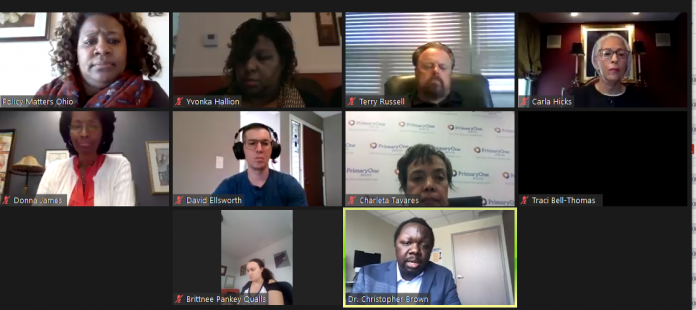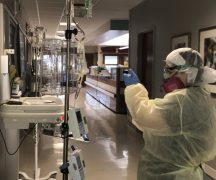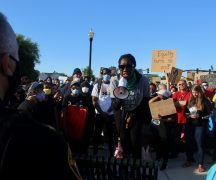By Susan Tebben
Medical professionals and minority advocacy groups came together last week to give their input on recommendations from the state’s coronavirus Minority Strike Force.
In three days of town hall meetings, strike force subcommittee members were advised on how to address multiple aspects of the minority community’s daily life that can contribute to health disparities.
The group was put together at the direction of Ohio Gov. Mike DeWine, who acknowledged in multiple press conferences that coronavirus disproportionately affects people of color, and disparities exist in public health in general that impact minority communities.
Subcommittees of the strike force include education and outreach, data and analysis, and health care. Members of the subcommittees include elected officials, religious leaders, medical professionals, and organizations focused on racial, gender, and socioeconomic equity.
The discussions during the town hall meetings ranged from the living conditions in public housing, to transportation as a barrier to health, language, food access, and racism as a whole, all of which are social determinants of health.
“We need to understand that the reason that African Americans are more susceptible to contracting and dying from COVID-19 is the underlying conditions,” said Dr. Charles Modlin, urologist and director of the Cleveland Clinic’s Minority Men’s Health Center.
Modlin said while African Americans represent 13% of the population in the state, they represent about 25% of coronavirus cases, more than 30% of the hospitalizations and 16.5% of the deaths.
Maternal and infant mortality
Maternal and infant mortality in black Ohioans is a big problem in the state, to the point where the legislature has created a caucus on the topic.
Retired pediatrician, obstetrician and gynecologist Dr. Arthur James said black babies die at a rate three times higher than white infants.
“Ohio is one of the worst performers in terms of keeping our babies alive,” James said.
During the education and outreach town hall, he said the fight against racial disparities should not only be reactionary, but preventive.
The infant mortality and maternal morbidity ties into many different aspects of African American life, including support mother’s receive during their pregnancy and as birth happens.
Jessica Roach, CEO of Restoring Our Own Through Transformation (ROOTT), which helps black families through direct services like education and pregnancy support, along with public policy, said COVID-19 has caused increases in adverse events and the need for adjustments from ROOTT.
Roach said family engagements have had to go virtual, along with labor and delivery support. The organization has seen increased requests for home-birth, premature scheduled inductions, and “adverse birth outcomes.”
“We’ve also seen increases in erroneous health information,” Roach said.
As part of their recommendations for the Minority Strike Force, Roach said allowances for perinatal support and doulas — childbirth support providers — inside labor and delivery are necessary to improve minority patient care.
Currently, there is a bill in the House Insurance Committee to establish a state doula registry (a doula is a woman, typically without formal obstetric training, who is employed to provide guidance and support to a pregnant woman during labor), and require doula services to be covered by the state Medicaid program. The bill has two Democratic primary sponsors and eight cosponsors, all Democratic.
Data and analysis
Seeing the data that supports the fact that race is a factor in health outcomes will help bring about policy and real-time change, according to those that spoke during the data analysis town hall.
“If we collect this data by race and ethnicity now…we will have a wealth of information to understand what helps (minority communities) not only survive but thrive,” said Marie Curry, of Ohio Consumers for Health Coverage.
Necessary data can include telehealth usage, copay costs, and the use of community health workers.
“We have to intentionally ask what black and other minority Ohioans need,” Curry told members of the subcommittee.
Not only is it important to have data about all Ohioans of color, but also those that make up the frontline workers, direct care, and educators. Women of color make up the largest and fastest growing segment of the direct care workforce who work with those with disabilities, according to Teresa L. Kobelt, director of strategy, innovation and forecasting for the Ohio Center for Autism and Low Incidence’s office of public policy.
“The poverty rate is higher in women (working) in direct care,” Kobelt said.
Kobelt said that ties in with the fact that 40% of early care workers — those that work with young children — are people of color. In comparison, 80% of K-12 teachers are white.
The different subcommittees were focused on identifying their target audience, along with key distribution channels and metrics to study.
A final report is upcoming from the Minority Strike Force, but they released an interim report which looked at immediate steps to stop progression of the disease, evaluate the impact, remedy factors contributing to the spread and obtaining resources to prevent resurgence among people of color in Ohio.
Among the recommendations in the interim report are an increase in “culturally appropriate and accessible” virus tracing and exposure notification, implementation of patient protection advocacy, expanded testing for minorities, and a statewide, “culturally sensitive” outreach campaign.
***
Also from Ohio Capital Journal.
New COVID-19 cases slow down over last month in Ohio
The rate of new COVID-19 cases in Ohio has trickled downward since early May, an analysis of state data shows.
The 10-day average of new cases peaked on May 10 (excluding a surge largely attributable to mass testing in state prisons) at roughly 640. Today that figure is down to an average of 456 new cases per day.
However, the Ohio Department of Health continues to report scores of deaths, hospitalizations and ICU admissions from COVID-19 every day, and public health officials urge citizens not to let their guards down against the virus. READ MORE
Sen. Portman heard from ‘dozens’ of black leaders. His office won’t name any.
U.S. Sen. Rob Portman has touted his participation in a conference call with “dozens” of black leaders discussing how COVID-19 and racial injustice has impacted their communities.
However, details about the call and who was invited to participate are not being disclosed.
Ohio’s elected officials, from city councils to the halls of Congress, are facing pressure to take action to address issues of systemic racism and police misconduct.
The Cincinnati Republican has spoken on the Senate floor about the need for police reforms and finding “solutions that promote strong families and communities that treat each other with respect and dignity.” READ MORE





